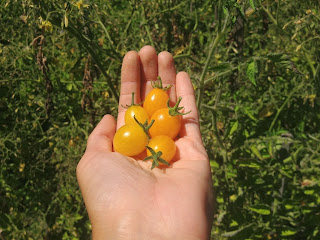Here's a collection of photos from some of our big harvest days.
Onion Harvest
July 13th we had a good stand of different onion varieties growing. We didn't grow as many onions as we had hope this year, mostly due to our inability to get the beds prepared in time. We had some early onion seedlings of australian brown and red and yellow cipollini that never got planted because we started them early and had beds ready too late and most of the seedlings didn't make it. We ended up having to buy 6packs of onion seedlings from Occidental Arts and Ecology Center. They worked out fine, but we didn't have as many onions as what we had planned for. The varieties we grew this year were red weathersfield, red creole, newburg, walla walla, yellow cipollini, deep purple scallion, and welsh onion.
We took out the bulk of the onion varieties by July 31st because they were starting to get some kind of mold on the leaves. We finished the curing process by building a makeshift shade structure for them to hang out on until ready for boxes.
By September 1st, we took out the last variety of onion, the walla walla sweet onions. We tried to leave them in the ground as long as possible to get a little bit bigger since they didn't have as big of a moldy leaf issue.
Potato Harvest
We've had various potato harvest days as we wanted to dig them up the day of or the day before they would go into a box. We grew a few different varieties of potatoes: canela russet, mountain rose, purple majesty, and la ratte. We tried to pick types that were early, mid and late season varieties to see which we would have the best success with. So far, we think that the fingerling potatoes, la ratte, have done the best for us. We only have some photos from one harvest day when we took out our first potatoes of mountain rose and purple majesty.




Just a small harvest for the first round of mountain rose and purple majesty. We have 8 potato boxes and each seemed to have various success rates. We are still trying to figure out the perfect potato growing conditions on our very gopher-centric farm. We won't be able to grow potatoes in these boxes for a handful of years as we need to rotate our crops to prevent disease. I think for next year, we might grow some herbs in some, some sunchokes in some and we'll see what else we can come up with.
the end of that one potato harvest day and the sun was going down and the clouds lit up in the sky.
Bean Harvesting
In early August, our bean beds were a lush stand of bush beans and semi-pole bean climbers. We harvested a little bit for green beans, but mostly our goal was to do the long wait for dry beans.
By late August, we had made one harvest of the earliest dry bush beans of calypso. We had to stash the curing pods in various places around our property and the farm.
And by early September, we were able to start harvesting some of the other dry
beans. We put the small batches into pillow cases and hung them on our
shady tree to continue to cure.
By the end of September, the rest of the dry beans were ready to harvest. The weather was cooling and there were many mornings with dampness that would bring about molds that would settle onto the pods. We needed to get the rest of them out of the field so we could start the process of cleaning them.
We got a a good amount of dry beans from all the varieties we grew, but we think our best was swedish brown, a Yeti favorite. Our other varieties we grew were red hopi and yellow hopi, calypso, and painted pony.
During one work party day, we did a blind taste test and we got some great feedback from our friends and their tested palates. First they got to look at all the bean varieties with two kinds thrown in that we weren't growing to confuse them, and then everyone was blindfolded and given a spoonful of each bean. The blindfolds were then removed and they had a chance to write down their thoughts on which variety it was and any notes on flavor and texture.
Yellow hopi was too thick skinned, as was painted pony. Red hopi had a
nice soft texture and a good beany taste, while calypso was well liked
for the most part, but swedish brown came out on top in flavor and
texture. All around our best bean for both growing ease and in the taste
test!
We've also had harvest days for sunflowers
Harvest days of our special peppers
These two photos below of the comapenos shows some oddly huge chiles!!
We've also been harvesting our hungarian paprikas for drying so we can have some spice in the winter months.
And on our final day with the cucumbers on October 21st, we started a fermentation of some lemon cucumber pickles
It was also our final day for our cherry tomatoes so we plucked off as many green tomato clusters as possible to continue ripening in our pantry at home.... until next season cherry tomatoes!






























































